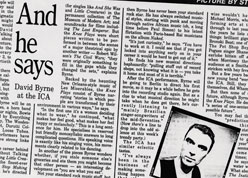ORIGINAL
PRESS CLIPPINGS

A ROBERT WILSON PROMER:
THE ENIGMATIC AUTHOR AND HIS "KNEE PLAYS"
But "the Knee Plays," originally intended to serve as interludic material between the 15 large scenes of "the CIVIL WarS," is short. It consists of 13 brief episodes — the longest no longer than six minutes — occupying a total of about 90 minutes in performance.
The brevity isn't the contradiction of Wilsonian principle it may seem. Among his many creations in other media was "Video 50," which was made up of 50 one-minute TV "spots," amusing, quirky, inventive vignettes to be sandwiched between regular programs. It's not that Wilson leans to one pole or the other, it's that he tends to extremes — when he's long, he's really long, and ditto with short.
And despite the terseness, you can count on "the Knee Plays" being pure Wilson. By another apparent paradox, that means it will be full of "impurities," in the sense of contributions from a multitude of idiosyncratic collaborators. In the case of "the Knee Plays," they include, besides Byrne, Japanese choreographer Suzushi Hanayagi, visual consultant Adelle Lutz, designer Jun Matsuno, a company of nine dancers and an ensemble of brass and percussion players under Byrne's direction. Yet every instant will bear the unmistakable imprint of Wilson, who is responsible for the conception, the scenario, the stage direction and the overall visual design.
The point is that if you go to the Warner looking for something like Neil Simon, or even Sam Shepard — though Wilson is certainly closer to the latter, if not in spirit, then in unconventionality — you'll quickly find that your expectations are misplaced. Despite its title and some of the circumstances — it happens on a stage, it has a script of sorts, and there is abundant play of imagination — "the Knee Plays" is not a "play" along any theatrically traditional lines. It has no realistic characters, no dialogue, no linear plot, and the kind of sense it's apt to make won't be literal, but rather, poetic. It would be more helpful to think of "the Knee Plays," as of other Wilson works, as a cascade of imagery — visual, aural, verbal and choreographic — centering around a number of key themes, rather than as drama in its ordinary meaning.
This is what makes Wilson special, but it's clearly not what everyone goes to the theater for. Which brings us back to why it's been hard to come by Wilson's work in this country. It's light-years from the commercial stage, and even for more venturesome theaters Wilson poses weighty obstacles, including the exceptional technical difficulties and costs of his productions. Accordingly, few of Wilson's major projects have found sponsorship here, with the brave exception — until recently — of the Brooklyn Academy of Music. Even "Einstein on the Beach" — his opera in collaboration with composer Philip Glass and by far his most widely known opus — had its premiere abroad, where admiration of Wilson has been and continues to be prodigious.